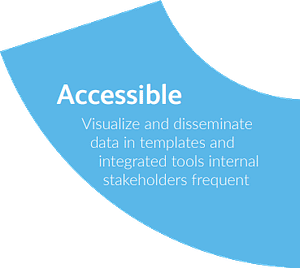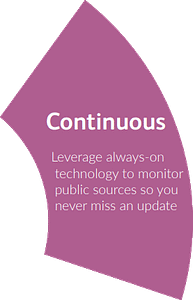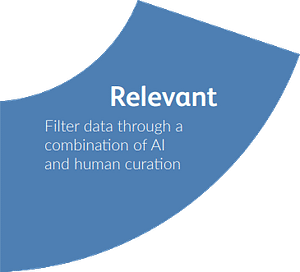Competitive Intelligence
The Ultimate Guide to a Successful AI-Powered Competitive Intelligence Program
Chapter 1
The Growing Need for AI in Competitive Intelligence
Competitive intelligence (CI) has made its way into organizations of every size. Starting with companies wanting to track competitor movements and decisions, CI is now a vital area enabling you to gain a competitive advantage.
of businesses are planning to invest in competitive intelligence.
of businesses are planning to invest in competitive intelligence.
Companies rely on Competitive Intelligence to:
Gain a Competitive Edge
Overcome Key Challenges
Spot New Opportunities
Whether it is quickly switching up tactics or adjusting a company’s overall direction, a reliable CI program has been at the helm of successfully pioneering these adaptations.
Traditional CI programs are hampered by stagnated and siloed insights, where analysis lacks flexibility and timeliness for companies to quickly adapt to new changes and stay ahead.
The current business environment is evolving at an accelerated pace. Paired with increasing market volatility, companies must monitor competitors and create strategies that maximize opportunities and reduce uncertainties.
To be successful, companies need to build a program that accounts for changes in the market, different situations and contexts, and areas that require specific domain knowledge.
Common Challenges & Limitations that Hinder CI Success
Surplus of data and noise
Fast rate of change
Lack of context in intelligence
Siloed teamsDecentralized information
Surplus of data and noise
Lack of context in intelligence
Fast rate of change
Siloed teams
Decentralized information
Successfully implementing a robust CI program helps companies break through the limitations of traditional intelligence, spot new opportunities for growth, increase market presence, quickly respond to threats, and stay ahead of the competition.
This ebook shows how companies can build a robust CI program by highlighting where technology falls short, common pitfalls, how to empower your CI teams, and instrumental elements to building a smart CI program.

OUTCOMES
Only 20% of analytics insights will deliver business outcomes through 2022
2019 Gartner Analytics and BI Solutions Study
Chapter 2
Evaluating Competitive Intelligence Technology
Competitive intelligence (CI) has made its way into organizations of every size. Starting with companies wanting to track competitor movements and decisions, CI is now a vital area enabling you to gain a competitive advantage.
To choose a tool that sets you up for success, you must:
Understand Internal Stakeholder Needs
Survey internal stakeholders to understand the type of intel they need to improve their job performance, how they receive it, and how they will interact with that intel.
Agree on Data Sources & Curations
Depending on your industry, public vs. private, and which internal stakeholders you serve, you will need different data sources. This ranges from different sources of web crawling and secondary research to the level of reliance you’ll have on primary research.
Benchmark
Understand where fall in relation to your objectives. Marking this helps you stay focused and measure long-term progress.
Determine Objectives
Look at what you’re doing well and what type of data or workflow you need to propel your company forward. For example, are you struggling to capture relevant intelligence or are you struggling delivering that to internal stakeholders?
When evaluating tools, it’s imperative to evaluate the one that will best fit your objectives. For example, if you’re in a niche market and have private competitors, AI-powered data collection might not move the needle for you.
In this case, it would be best if you look to domain experts to perform primary research. By contrast, if you’re in a saturated market with public behemoth competitors, AI capabilities with state-of-the-art filtering combined with additional expert curation of intelligence will be critical to seeing success.
When looking at the most successful CI programs, there are 5 principles the tools supply that propels them:





1. Comprehensive
Monitor intelligence on competitors, markets, suppliers, and key accounts2. Continuous
Leverage always-on technology to monitor public sources so you never miss an update3. Relevant
Filter data through a combination of AI and human curation4. Accessible
Visualize and disseminate data in templates and integrated tools internal stakeholders frequent5. Actionable
Proactively provide easily understandable, curated intelligence to internal stakeholdersCHAPTER 3
Side-Step Common Competitive Intelligence Pitfalls
Chapter 3
Side-Step Common Competitive Intelligence Pitfalls
With 94% of businesses investing in competitive intelligence, there is no denying the rising importance that CI initiatives play for organizations.
However, organizations are still struggling to see ROI from their CI platforms or solutions in a short amount of time.
VentureBeat AI reports 87% of data science projects never make it into production, which leads to the next question— why? In our 20 year-long experience working with industry leaders around the world, we have observed quite a few competitive intelligence pitfalls that organizations fall into.
The Common Pitfalls of Competitive Intelligence








Pitfall #1
Too Much Emphasis on AI Data Collection
There are millions of web sources CI teams could look at monitoring. However, once key sources (i.e. news, websites, social, reviews, job postings, etc.) are covered, you run into the problem of having an excess of information causing wasted effort and amplified noise.
Instead, focus on quality, available workflows, relevancy of the intelligence, and making it accessible and actionable to internal teams. After all, having more data doesn’t matter if it isn’t used to move the business forward.
Pitfall #2
Using Multiple Competitive Intelligence Tool
There are many CI tools on the market. Some focus on data collection, others knowledge management, social monitoring, the list goes on. And then there are full-function platforms.
To be successful, choose a tool that meets your objectives, provides room to grow—and most importantly—helps you focus on what matters. If you have multiple use cases, select a platform that supports all of them instead of piece-mealing products together. Using multiple CI platforms can leave you vulnerable to communication breakdowns, inconsistent insights, and slow response times to important events.
If you evaluate your current CI program and find that your platform is missing critical elements such as speed, consistency, growth, and shareability, then it’s time to start looking at fresh solutions that will help you meet these new objectives.
Pitfall #3
Integrating Too Quickly
With the excitement of onboarding a new platform, there’s a tendency to set up integrations and alerts without understanding what type of intel teams need, where they need to access it, and training them on using it.
Often, we see that most mature teams wait 6-months to a year before they set up integrations with Salesforce, Teams, Slack, etc.
Prior to the setup, these teams get feedback from power users on the type of intel and where and how they interact with it. The best practice here is to get success stories to share on how the intel is used to build excitement during broader team training.
1. Survey team
on desired intel
2. Configuring AI
for relevancy
3. Enable alerts,
newsletters, integrations
4. Gather feedback at
regular intervals
to improve outcomes
Pitfall #4
Prioritizing Information Over Insights
Information is inescapable. We are constantly being bombarded by information in the form of newsletters, social media updates, newsfeeds, alerts, and more.
15 years ago, the main sources to track were websites and news sources. Today, CI research needs to include websites, review sites, social media, GitHub, discussion forums, videos, etc.
Given the number of sources, separating signal from noise is a common challenge. AI and ML-powered platforms help to collect and filter this information. These engines learn what’s relevant over time so open feedback loops are key to success.
Pitfall #5
Siloing Intelligence and Insights
Intelligence comes from many sources – public sites, commissioned research, sales intel, CRMs, BI tools, etc. Siloed information can lead to duplications of efforts, fragmented perspectives, and a lack of synergy between team members.
Combat siloed intel with a CI tool capable of sourcing, managing, visualizing, and collaborating with all sources of knowledge. Teams will be able to quickly access information and synergize with each other.
These factors can create an environment where it is difficult for teams to prioritize and align their goals. Without the right competitive intelligence platform, organizations will not have the coordination and speed needed to surpass their competitors.
RESULTS
2x Better Results When Measuring CI Weekly
2021 State of Competitive Intelligence, SCIP
Pitfall #6
Relying on Inconsistent Reports When Making Decisions
Timing is everything. If key decision-makers do not have the insights they need at the right time, how can they make the right decisions?
Research-backed CI teams typically create static reports shared via PowerPoint monthly or quarterly. These reports are put together via quarterly company reports and historic sales intel. This approach ignites trouble as decision-makers are using out-of-date information.
Organizations do not function in a vacuum. They are affected by trends, competitor updates, and natural disasters. Insights should be continuously updated and disseminated so that key decision-makers can lead organizations in the right direction.
Pitfall #7
Overreliance on AI & ML
AI and ML are powerful features for collection, filtering, and distributing intel to key stakeholders. While incredibly powerful for some, they can also be a fruitless endeavor.
AI and ML are excellent if your competitors are large
and/or public companies where there is a lot of
information to sift through.
Organizations do not function in a vacuum. They are affected by trends, competitor updates, and natural disasters. Insights should be continuously updated and disseminated so that key decision-makers can lead organizations in the right direction.
However, be wary of two scenarios:
Noisy Competitors
AI and ML will help gather and filter but lacks context. You still need analysts to create the “so what” takeaway.
Without Noisy Competitors
Look at improving field intel, CRM measurement, and secondary and primary research to unearth key movements over AI and ML
CHAPTER 4
Empower Your Competitive Teams Intelligence with Scalable Technology
Chapter 4
Empower Your Competitive Teams Intelligence with Scalable Technology
Even with new advances in AI-powered CI technology, teams are facing common challenges such as:
Serving Diverse Internal Stakeholders
The average CI team is 3-5 people serving 500+ internal stakeholders across marketing, sales, executives, product, and procurement. Each stakeholder needs intelligence specific to their objectives which is incredibly hard to source and distribute at scale.
Measuring RoI of Program
Being an internally facing team, CI teams often find that their budgets are one of the first to be cut. Proving value through both adoption and stakeholder impact is critical to scaling up your program.
Low Adoption Rates Across Teams
Adding a new one to the mix can be met with a lack of enthusiasm and feelings of being overwhelmed. Starting rollout with power users, proving an initial success, and then surveying for the type of intel and desired integrations to scale helps improve this.
Hard to Distribute Intelligence
Serving diverse internal departments elicit difficulty in providing the intelligence in tools and formats each team actively uses. While email is still the most popular distribution channel, integrations, workflows, and curation increase both the adoption and actionability of insights.
When pairing AI and expert curation, teams are seeing a 174% increase in adoption due to higher levels of context.
With industry changes becoming a common occurrence, CI teams are struggling to gather accurate insights, collaborate with team members, and centralize this information in one place. Any failure to keep up with these changes can result in organizations getting blind-sided by new developments or find that they focused on the wrong peer or themes.
Some of the ways that a CI team can combat the challenges above is through establishing an overall program that empowers CI teams with:
- Timely and actionable insights focusing on competitors and topics.
- Forward-looking analysis based on competitor movements.
- A holistic picture of the direction competitors are headed—all in one place.
- Scalable and capable of adding new competitors and tag/themes at any time.
- Solution agnostic of geography, service line, or industry for accurate and unbiased analysis.
- Centralized insights that can be used across the firm and departments.
- Self-serve capabilities that leverage both the firm’s internal and external data.
- Collaboration capabilities enabling the CI team to share/flag something new or disruptive.
These capabilities ensure that the CI team can spend less time manually researching, gathering, and tagging information and instead spend more time analyzing and identifying white spaces, differentiators, and opportunities.
By utilizing a platform that is powered by artificial intelligence (AI), machine learning (ML), and natural language processing (NLP), CI teams will be able to make actionable suggestions that directly impact decision-making.
The combination of internal and external knowledge with domain expertise creates a 360-degree view of the competition, which would have been limited due to the platform or team constraints.